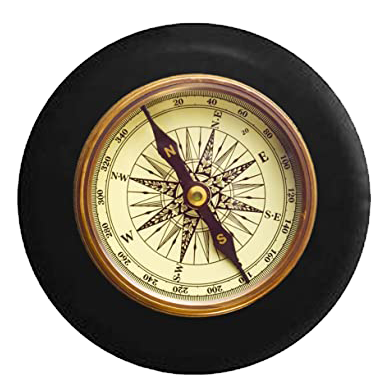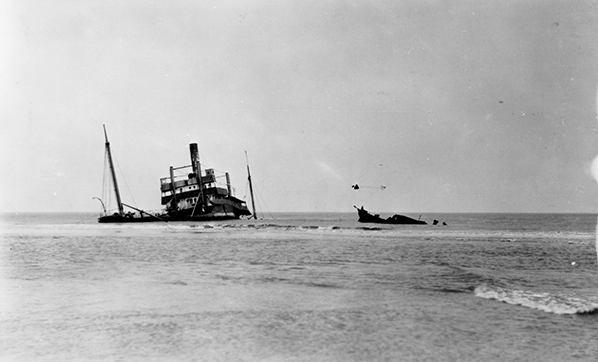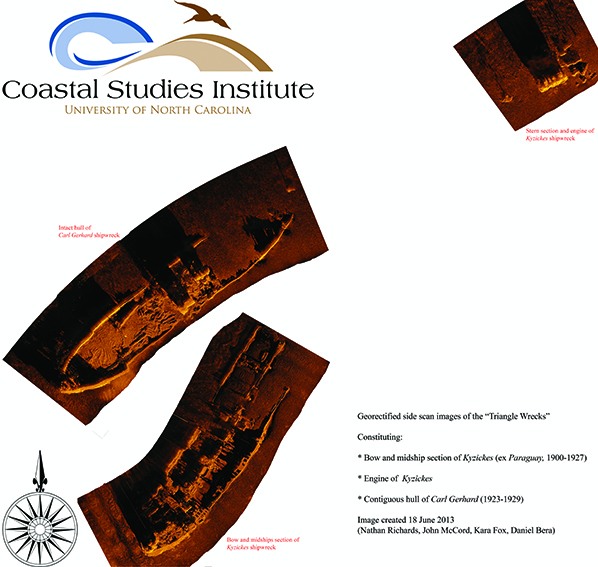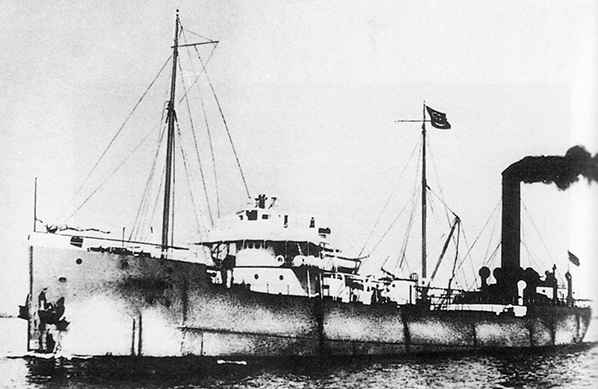
Kyzikes in port. Photo courtesy of U.N.C. Coastal Studies Institute.
The Sinking of the Kyzikes:
The ship began its life as the S.S. Paraguay carrying ore on the Great Lakes in 1900. The owner of the ship, A.B. Wolvin, sold the ship to Sun Oil due to the declining freight rates. Sun Oil converted the ship into its first oil tanker. on March 20, 1902, she arrived in Marcos Hook, PA with its first load of Texas oil. Between 1902 and 1924 the ship sailed on a regular basis between Marcos Hook and Texas. It also made two trips across the Atlantic. As the years went on the 242' tanker became somewhat obsolete. By the mid-1920s tankers were being built with much larger capacity. On August 23, 1927, the Unites States Shipping Board approved the sale of the Sun Oil tankerParaguay to Costi Xydia and Sons who renamed the ship Kyzikes. The sale came with the stipulation that it couldn't engage in trade with ports with the continental United States.
It was reported that the tanker left on its maiden voyage as the Kyzikes from Baltimore on November 28, 1927, with Captain Nicklos Kantanloas in command. With him was a crew of 28 and a full cargo of oil headed to Seville, Spain. Three days into their voyage the tanker began to take on water and the captain ordered it back to Baltimore. On November 30, the Kyzkikes headed back to sea. The following day, Friday, December 1 the tanker encountered a storm out of the northeast. The crew at the time tried desperately to pump water out of the tanker. However, the storm seemed too fierce for them to get the upper hand.
By noon the following day, December 2, the first series of wireless messages from the tanker were received by shore stations and other vessels. At that time, the Kyzikes was about 200 miles east of the Virginia capes. The whole time it was being severely beaten and battered by the storm and it was leaking from bow to stern.
At 4:30 PM on December 3 the Kyzikes transmitted a message of distress: "Leaking fore and aft badly. In need of assistance. Position latitude 36-35 north, longitude 75-50 west. Unless you get to us quickly we may not be here. We tried to steer westward but drifting southward. Heavy seas running."
The Baron Harries, City of Atlanta, East Indian, Harvester, St. George, and Oxholm. Also, the Coast Guard cutter Carrabassett based in Norfolk headed out to sea to assist in the search for the tanker. Sensing the desperation from the last transmission, several ships headed in the direction of the tanker. At the time the closest ship was about 60 miles away. It wasn't too much later that all transmissions stopped from the tanker. During the fierce storm, a huge wall of water hit the ship broadside and tore off the wireless antenna. Fortunately for them, the City of Atlant was near enough to keep transmitting the call for help.
Baron Harries finally reached the area that the Kyzikes had reported being located. At that point, the Coast Guard released the other rescue vessels from the search. The bad news was that by that time the tanker had drifted so far from where she first reported being she could not be located.
By the night of December 3, four men had been washed overboard and were lost. To make matters worst, the ship's boilers were extinguished and the engine had stopped. Now they faced a situation where they had no power and no lights which now created two new problems: 1) without power they were left to the mercy of the raging sea; 2) with no lights no other ships would be able to see them at night.
Throughout the night the Kyzikes continued to be battered by the sea. Throughout the night in the stormy darkness signal lights were seen nearby from the bridge of the tanker. They were happy and a sense of relief arose from the men when they were able to see returning signals from what they thought was a rescue ship. By daybreak, on December 4 she struck Diamond Shoals. Stuck on the shoals with waves breaking over the deck the worst battering the Kyzikes was taking. With the light of day what they began to realize was that the signals they were seeing overnight were actually signal lights from their own ship. What had happened was the stern end of the ship had broken off and had swung around alongside the bow portion. The signals had come from five men who had been trapped there when that portion of the ship broke off.
At that time a large plank was laid across space between the two parts of the ship and the five crewmen on the stern crossed over to the bow to join the captain and 19 other surviving crewmen.
Fortunately, the Kyzikes had been seen by lifesavers from Kill Devil Hills and Nags Head. They fired a Coston flare to let the Kyzickes that help was on the way. The lifesavers attempted to launch surf-boats, but each time they attempted to launch a boat the rough sea would push them back. They finally resorted to the Lyle gun (a short-barreled cannon designed for the rescue of persons in distress by the firing of a projectile with a line attached for the purpose of allowing for transport of those persons to a place of safety). With powder and a shot, they fired a messenger line over the rigging, attached the hawser, and set up a breeches buoy. They then began to pull the survivors to the beach one at a time. By 7:00 PM that night, Captain Kantanlos and the 24 crewmen were safely ashore.
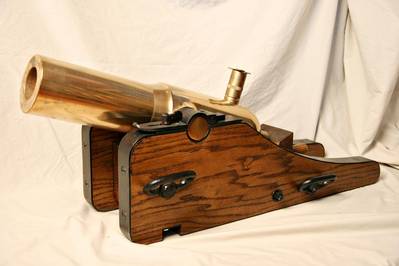 A life-saving cannon - Lyle Gun
A life-saving cannon - Lyle Gun
Two years after the grounding, the U.S. Army used the Kyzikes for target practice. In 1929, six Keystone bombers practiced bombing from various heights. They were quite successful in their bombings. To add it its destruction, that same year the vessel Carl Gerhard ran aground at the exact same location. It plowed through the remains of the Kyzikes further destroying what remained of the tanker.
THE SHIP'S SPECIFICS:
| Built: 1900 | Sunk: December 1, 1927 |
| Type of Vessel: Tanker | Owner: Costi and Michael Xydia, Peter Paramythiotis |
| Builder: American Shipbuilding Co., A.B. Wolvin, Lorain, OH | Power: Coal-fired Steam engine |
| Port of registry: Baltimore, MD | Dimensions: 292' x 42' x 23' |
| Previous Names: Paraguay |
LOCATION OF THE SINKING:
Here is the location of the sinking: 36°06'52.7"N, 75°40'06.0"W
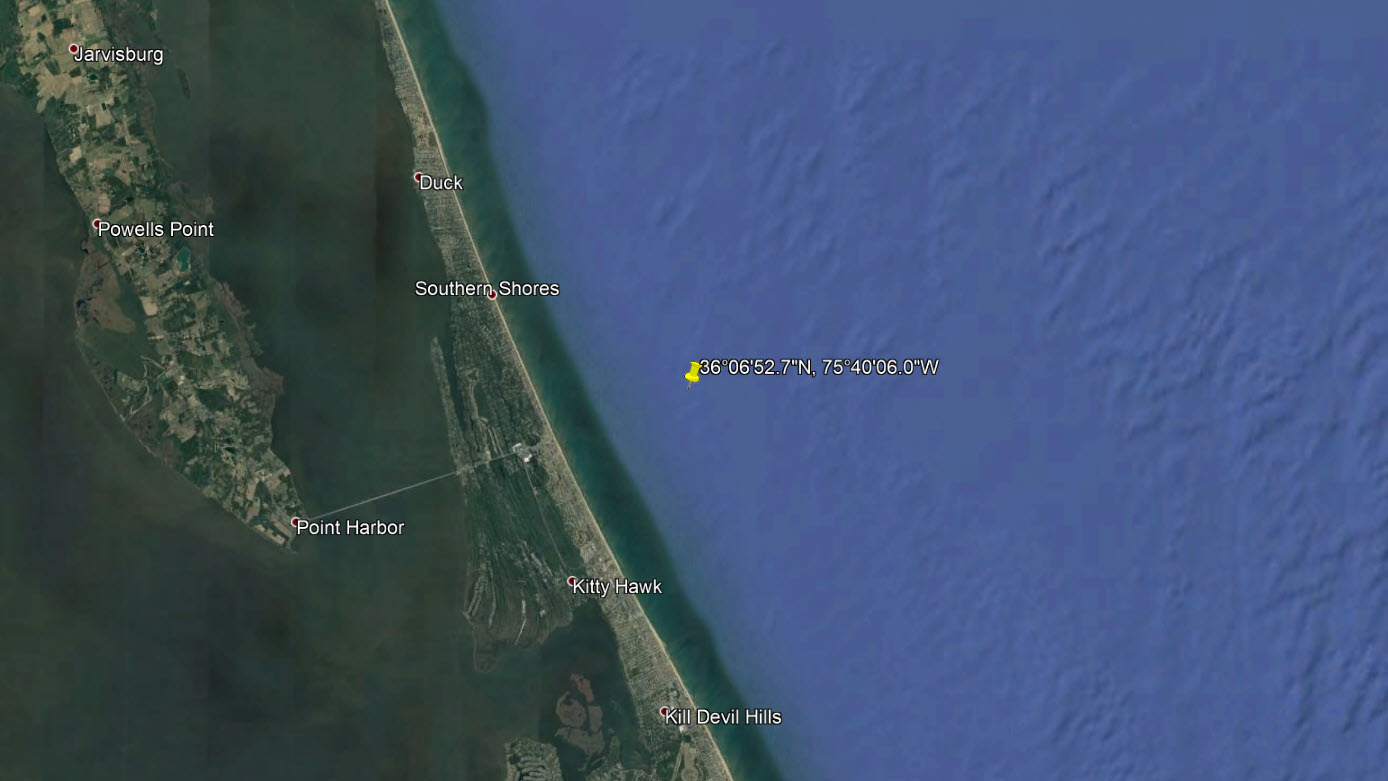
LOST CREW MEMBERS :
| Last | First | Date of Death | Position | Home | Age |
|---|---|---|---|---|---|
SURVIVING CREW MEMBERS :
A partial listing of the surviving crew: Total Crew Lost: 4, Survivors: 16
| Last | First | Position | DOB | Home | Age |
Additional Photos:
|
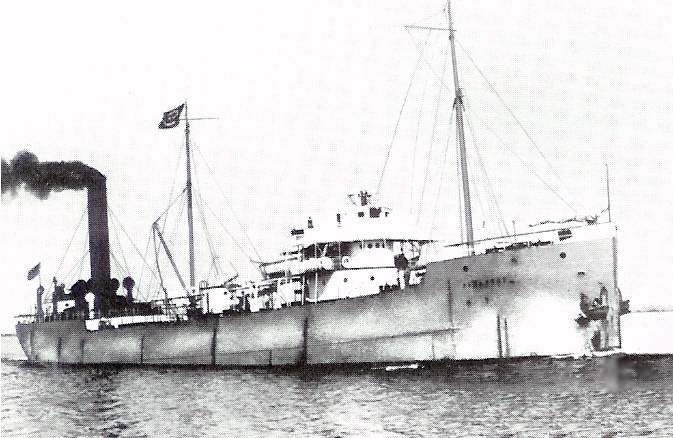
Kyzikes when it was known as Paraguay. |
|
|
